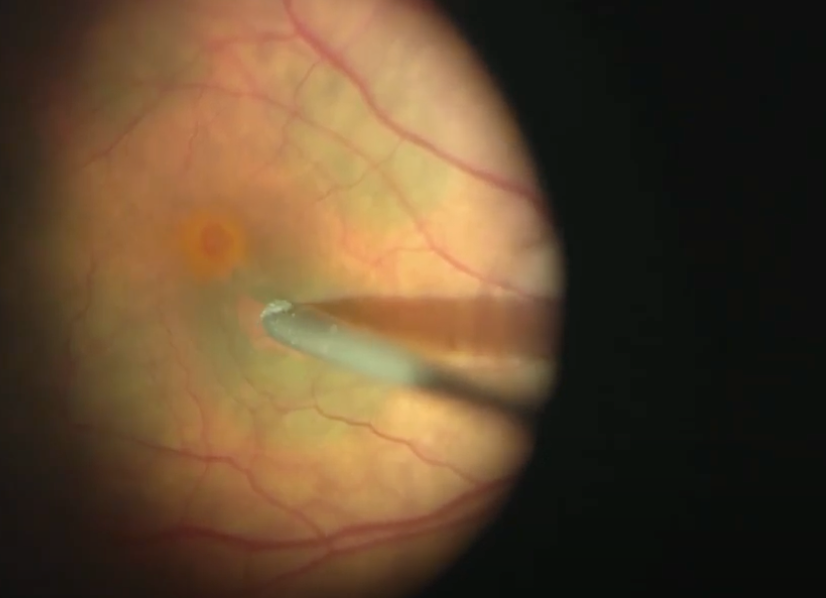Article
(AAO) Micro vacuum pick for vitreoretinal surgery may be a better mousetrap
Author(s):
During Day 1 of AAO 2020, Carl Awh, MD, discusses the Micro-Vacuum Pick, a device for peeling internal limiting membranes that's providing vitreoretinal surgeons an alternative to forceps during surgeries.
Micro-Vacuum Pick (MVP) (Katalyst Surgical)

Reviewed by Carl Awh, MD
A new device for peeling internal limiting membranes (ILMs) and epiretinal membranes (ERMs) provides vitreoretinal surgeons an alternative to forceps during vitreoretinal surgeries.
During the opening day of the American Academy of Ophthalmology’s virtual 2020 annual meeting, Carl Awh, MD, highlighted the Micro-Vacuum Pick (MVP) (Katalyst Surgical).
Dr. Awh designed the device, which can be used to create a membrane edge, secure the membrane, peel it from the retina, and remove it without removing the instrument from the eye; fluid-air exchange can also be performed when needed.
With all of these capabilities, the number of instrument exchanges decreases, its use may eliminate the need for forceps and scrapers, and it may even cause less trauma to the macula. The device is available with 23-, 25- and 27-gauge shafts.
“The MVP is a multi-function device with active aspiration controlled by a foot pedal, using the active extrusion function of a vitrectomy machine,” said Dr. Awh, who is in private practice at Tennessee Retina in Nashville, TN.
At the distal end of the MVP is smooth primary spatula that is designed to lift membranes but not shred them. The spatula shields the retina from the vacuum port, which is located much closer to the tip than the port of a vitrectomy cutter.
It is small enough to create vacuum holding force but is sufficiently large enough to allow pieces of membranes to be aspirated out of the eye through the lumen of the MVP.
Two micropicks, one on each side of the tip, can be used to create an edge or flap in the membranes, and importantly, this is done with minimal risk of damaging the underlying retina.
Dr. Awh showed surgical videos of the MVP in cases of epiretinal membrane, macular hole, and traction retinal detachment. He used the MVP to perform the fluid-air exchange in the macular hole case, eliminating the need for a separate extrusion cannula.
Performance
Dr. Awh has used the MVP in more than 100 cases, the majority of which were performed to treat ERMs or macular holes.
However, he has also used the MVP for more complicated cases such as diabetic traction detachment, myopic retinal detachment, and proliferative vitreoretinopathy retinal detachment. The 25-gauge model was used in most cases; 3 cases each were performed using the 23- and 27-gauge models.
In only 10 of the 100 cases, an instrument exchange was needed to wipe a fragment of a membrane that clogged the port of the device. No iatrogenic retinal breaks or other complications were observed.
Based on the device’s performance, Dr. Awh highlighted its advantages.
“I find the MVP to be more stable device and less fatiguing, in that there is no need to activate forceps with my hand,” he said. “The device reduces or eliminates the need to remove and wipe forceps. The teasing action used to peel the membranes may transmit less stress to the macula than when peeling the membranes with forceps.”
An expected disadvantage is the need for the surgeon to learn new techniques with a new device, particularly the use of the micropicks to create the initial membrane flap or edge. Also, the MVP may be less effective for peeling very thick or rigid membranes, he explained.
A retrospective outcomes analysis is underway in which the 6-month postoperative outcomes using forceps are being compared with the 6-month outcomes using the MVP following peeling of ILMs and ERMs.
--
Carl Awh, MD
E: carlawh@gmail.com
Dr. Awh is a consultant to and owns stock in Katalyst Surgical. Patents are pending for this device.
Newsletter
Don’t miss out—get Ophthalmology Times updates on the latest clinical advancements and expert interviews, straight to your inbox.




